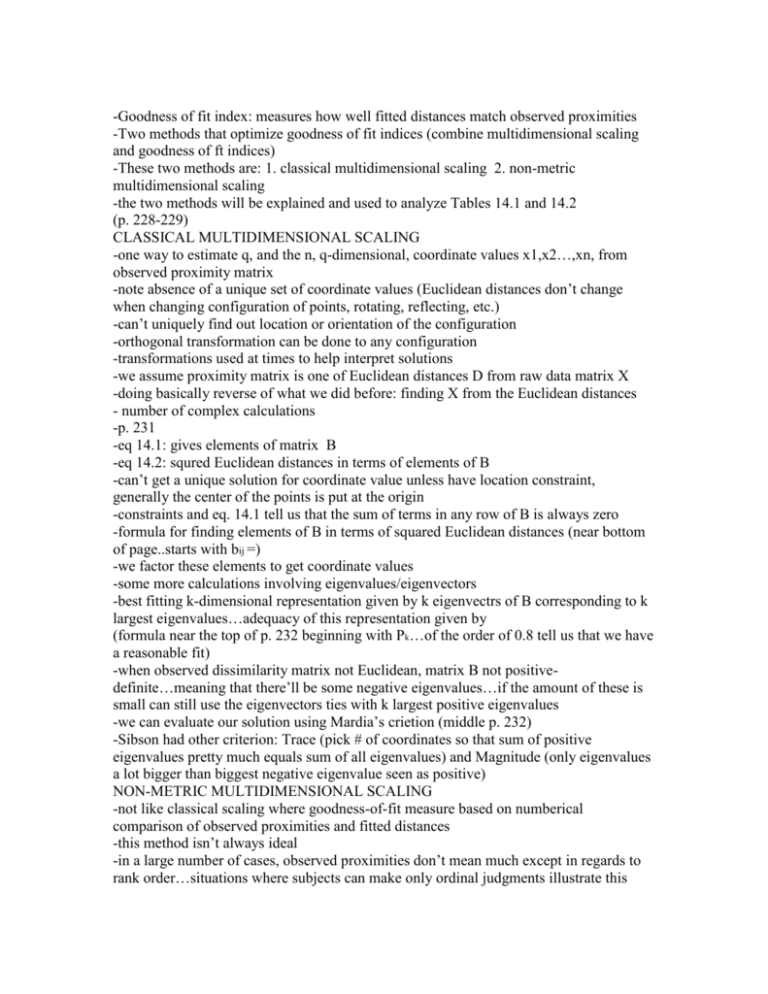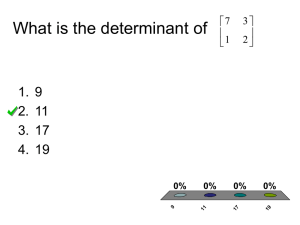-Goodness of fit index: measures how well fitted distances match
advertisement

-Goodness of fit index: measures how well fitted distances match observed proximities -Two methods that optimize goodness of fit indices (combine multidimensional scaling and goodness of ft indices) -These two methods are: 1. classical multidimensional scaling 2. non-metric multidimensional scaling -the two methods will be explained and used to analyze Tables 14.1 and 14.2 (p. 228-229) CLASSICAL MULTIDIMENSIONAL SCALING -one way to estimate q, and the n, q-dimensional, coordinate values x1,x2…,xn, from observed proximity matrix -note absence of a unique set of coordinate values (Euclidean distances don’t change when changing configuration of points, rotating, reflecting, etc.) -can’t uniquely find out location or orientation of the configuration -orthogonal transformation can be done to any configuration -transformations used at times to help interpret solutions -we assume proximity matrix is one of Euclidean distances D from raw data matrix X -doing basically reverse of what we did before: finding X from the Euclidean distances - number of complex calculations -p. 231 -eq 14.1: gives elements of matrix B -eq 14.2: squred Euclidean distances in terms of elements of B -can’t get a unique solution for coordinate value unless have location constraint, generally the center of the points is put at the origin -constraints and eq. 14.1 tell us that the sum of terms in any row of B is always zero -formula for finding elements of B in terms of squared Euclidean distances (near bottom of page..starts with bij =) -we factor these elements to get coordinate values -some more calculations involving eigenvalues/eigenvectors -best fitting k-dimensional representation given by k eigenvectrs of B corresponding to k largest eigenvalues…adequacy of this representation given by (formula near the top of p. 232 beginning with Pk…of the order of 0.8 tell us that we have a reasonable fit) -when observed dissimilarity matrix not Euclidean, matrix B not positivedefinite…meaning that there’ll be some negative eigenvalues…if the amount of these is small can still use the eigenvectors ties with k largest positive eigenvalues -we can evaluate our solution using Mardia’s crietion (middle p. 232) -Sibson had other criterion: Trace (pick # of coordinates so that sum of positive eigenvalues pretty much equals sum of all eigenvalues) and Magnitude (only eigenvalues a lot bigger than biggest negative eigenvalue seen as positive) NON-METRIC MULTIDIMENSIONAL SCALING -not like classical scaling where goodness-of-fit measure based on numberical comparison of observed proximities and fitted distances -this method isn’t always ideal -in a large number of cases, observed proximities don’t mean much except in regards to rank order…situations where subjects can make only ordinal judgments illustrate this -Example: if subjects asked to say which color brighter than another they can put in order but can’t quantify the extent something differs - solutions of this type of scaling rely solely on rank order of proximities, don’t worry about numerical values -monotonically transforming proximities shouldn’t change solutions -Monotonic Regression…goal: represent fitted distances were disparities monotonic with observed proximities and resemble fitted distances as much as possible -having a set of disparities in hand, can find needed coordinates by minimizing a function of squared differences b/w observed proximities and derived disparities (called stress)







